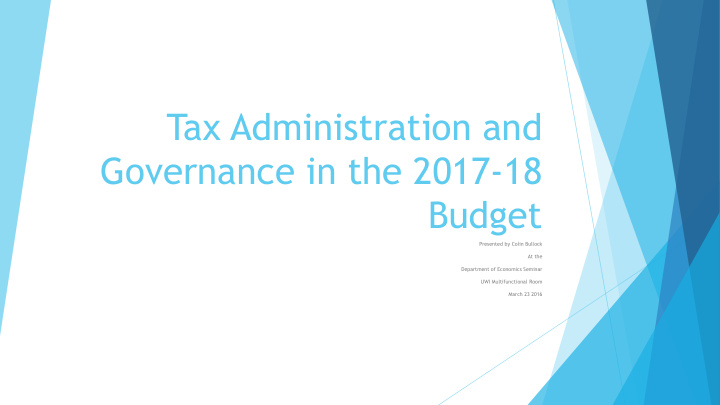



Tax Administration and Governance in the 2017-18 Budget Presented by Colin Bullock At the Department of Economics Seminar UWI Multifunctional Room March 23 2016
OVERVIEW Taxation and social contract Conflicting characteristics of an optimal tax system Who is taxed vs who pays A sketchy history of tax reform in Jamaica Measures to finance Government 2017-18 Contextual factors on funding Government 2017-18 Recommendations
Taxation and Socio-Political Organization Organized society requires government providing at minimum: internal security including protection of property rights and defence against external threats. . Governmental support of health, education and shelter emerges from a sense of “entitlement” but with increasing realization that they are essential to social cohesion and socio-economic development. Financing of major infrastructure and socio-economic development falls to Government because of size and multi- faceted composition. No free lunch. Taxation and social contract. Resource distribution, education and the principal-agent problem.
Characteristics of an Optimal Tax System Simplicity, transparency/responsiility, fairness/equity, efficiency, economic growth The challenge of balancing these characteristics in translating theory into policy e.g. a poll tax is simple but not “fair” If indirect taxes are efficient (re market forces and coverage) they are not necessarily fair regarding people’s ability to pay (amount paid vs percentage of income paid). “Fairness” is a “beauty contest”. “Transparency” depends on the Government’s motives and what people understand them to be. Electoral advantage?
Incidence of Taxation: Who Pays? Indirect taxes are seen as having wider taxpayer coverage but are potentially regressive relative to people’s income. In shifting from direct to indirect taxes, a highly uneven distribution of income and wealth is likely to require a disproportionate widening of social safety nets; creating a basis for even more taxation. The payment of indirect taxes depends more on the responsiveness of demand and supply rather than on who is charged to pay the tax to Government. Taxing the production of alcohol is paid largely by the consumer if demand is relatively unresponsive. A tax on staff benefits is paid by workers if supply of labour is unresponsive relative to the demand for labour.
A Brief History of Tax Reform in Jamaica Jamaica entered independence with taxation being largely dependent on border taxes at very high rates and progressive personal income tax paid largely by “captive” public sector P .A.Y .E. employees. The effective rate of compliance on Corporate Income Tax has been very low (Bahl & Wallace and Matalon Committee), compounded by a disorderly system of tax incentives. GCT (a Value Added Tax) as a major departure, was introduced in early 1990s. Matalon Committee in 2004 recommended continuing replacement of direct with indirect taxes to include broadening of indirect tax coverage and lowering of rates. 2012 reform directed largely at rationalizing tax incentives.
Measures To Fund Government 2017-18 Measure J$Bn Increase in specific SCT rate on alcoholic beverages to $1230 per lpa 0.403 Increase in specific SCT rate on various alcoholic beverages 7.459 Increase in SCT on tobacco products/substitutes per stick to $17 0.826 Reduction in zero rated electricity consumption threshold 1.498 GCT on Group Health Insurance Premiums 1.884 With holding tax on Insurance Premiums Paid Overseas 0.990 Increase in motor vehicle license and related fees 0.464 TOTAL OF CONSOLIDATED FUND TAX MEASURES 13.524 Modifications to Property Tax Base and Rate Structure 3.93 Transfer from National Housing Trust 11.5 TOTAL FLOWS TO GOVERNMENT 28.954 Increase in tax free threshold to $1.5mn (14.2)
Contextual Factors Mixed messages on “sin taxes” (health vs revenue) where responsiveness to price changes is not constant at all prices. Reduction in electricity consumption threshold to encourage conservation: so why not reduce threshold to zero. A tax on group insurance premiums is a tax on both employers and employees and may is likely to result in reduced benefits and/or higher costs especially through relatively small companies. Reduction in electricity zero rated threshold and increases in SCT on fuels and motor vehicle licences and rates will have a disproportionate impact on people of relatively modest means. Pensioners and others earning less than J$1 bn will bear a disproportionate burden of property, fuel, electricity and motor vehicle taxes. The full PIT benefit of threshold adjustment phase II will accrue to those earning $1.5 mn or above although facing some indirect tax increases.
Summary Recommendations Taxation as social contract (with crime, education, health) to be above partisan opportunism_ utilize Parliamentary Committee on Taxation. Balancing theoretical idealism with objective reality of socio- economic inequity. Direction vs speed of adjustment in rebalancing from direct to indirect taxes with lower income families including pensioners. Imperative to measure need and provide adequate social safety nets. Imperative for appropriate social policy: socio-economic opportunity in health, education, security, employment vs facilitating belief in free lunches.
Recommend
More recommend